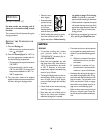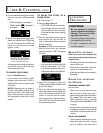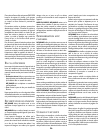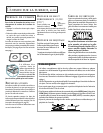
FOR MOST CONCERNS, TRY THESE
FIRST
:
• Check if oven controls have been properly
set.
• Check to be sure plug is securely inserted
into receptacle.
• Check or re-set circuit breaker. Check or
replace fuse.
• Check power supply.
SURFACE BURNER FAILS TO LIGHT.
• Check to be sure unit is properly con-
nected to power supply.
• Check for a blown circuit fuse or a tripped
main circuit breaker.
• Check to be sure burner ports or ignition
ports are not clogged. See page 4.
• Check to be sure ignitor is dry and clicking.
Burner will not light if ignitor is damaged,
soiled or wet. If ignitor doesn’t click, turn
control knob OFF.
THE FLAME IS UNEVEN.
• Burner ports may be clogged.
SURFACE BURNER FLAME LIFTS
OFF
PORTS.
• Check to be sure a pan is sitting on the grate
above.
BAKING RESULTS ARE NOT AS
EXPECTED
OR DIFFER FROM
PREVIOUS
OVEN.
• Check the oven temperature selected. Make
sure oven is preheated when recipe or
directions recommend preheat.
• Make sure the oven vent has not been
blocked. See pg. 9 for location.
• Check to make sure range is level.
• Temperatures often vary between a new
oven and an old one. As ovens age, the oven
temperature often “drifts” and may be-
come hotter or cooler. See pg. 8 for
instructions on adjusting the oven tempera-
ture. NOTE: It is not recommended to
adjust the temperature if only one or two
recipes are in question.
• Use correct pan. Dark pans produce dark
browning. Shiny pans produce light brown-
ing. See “Cooking Made Simple” book-
let for more information on bakeware.
• Check rack positions and pan placement.
Stagger pans when using two racks. Allow
1-2 inches between pans and oven wall.
• Check the use of foil in the oven. Never use
foil to cover an entire oven rack. Place a
small piece of foil on the rack below the pan
to catch spillovers.
FOOD IS NOT BROILING PROPERLY
OR
SMOKES EXCESSIVELY.
• Check oven rack positions. Food may be too
close to flame.
• Aluminum foil was incorrectly used. Never
line the broiler insert with foil.
• Trim excess fat from meat before broiling.
• A soiled broiler pan was used.
OVEN WILL NOT SELF-CLEAN.
• Check to make sure the cycle is not set for
a delayed start. See pg. 17.
• Check if door is closed.
OVEN DID NOT CLEAN PROPERLY.
• Longer cleaning time may be needed.
• Excessive spillovers, especially sugary and/
or acidic foods, were not removed prior to
the self-clean cycle.
OVEN DOOR WILL NOT UNLOCK
AFTER
SELF-CLEAN CYCLE.
• Oven interior is still hot. Allow about one
hour for the oven to cool after the comple-
tion of a self-clean cycle. The door can be
opened when the LOCK indicator word is
not displayed.
MOISTURE COLLECTS ON OVEN
WINDOW
OR STEAM COMES FROM
OVEN
VENT.
• This is normal when cooking foods high in
moisture.
• Excessive moisture was used when clean-
ing the window.
THERE IS A STRONG ODOR OR
LIGHT
SMOKE WHEN OVEN IS
TURNED
ON.
• This is normal for a new range and will
disappear after a few uses. Initiating a clean
cycle will “burn off” the odors more quickly.
• Turning on a ventilation fan will help re-
move the smoke and/or odor.
• Excessive food soils on the oven bottom.
Use a self-clean cycle.
“F” PLUS A NUMBER APPEARS IN
THE
DISPLAY.
• This is called a fault code. If a fault code
appears in the display and beeps sound,
press the Stop/Clear pad. If the fault code
and beeps continue, disconnect power to
the appliance. Wait a few minutes, then
reconnect power. If fault code and beeps
still continue, disconnect power to the
appliance and call an authorized servicer.
• If the oven is heavily soiled, excessive flare-
ups may result in a fault code during a clean
cycle. Press Stop/Clear pad and allow the
oven to cool completely. Wipe out excess
soil, then reset the clean cycle. If the fault
code and beeps still continue, disconnect
power to the appliance and call an autho-
rized servicer.
BEFORE YOU CALL FOR SERVICE
22


















